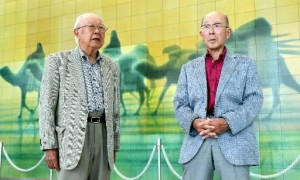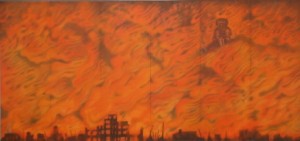Summer of President Obama’s visit to Hiroshima: 52 significant minutes, Part 4
Jul. 23, 2016
Part 4: Artist Ikuo Hirayama’s work stirred by his A-bomb experience
by Yumie Kubo, Staff Writer
After writing a message in the guestbook at the Hiroshima Peace Memorial Museum, U.S. President Barack Obama stood and turned to look at a large ceramic mural. The mural is found on the wall of the first floor of the east building of the museum, located in the Hiroshima Peace Memorial Park in Naka Ward. It was May 27, and it was Mr. Obama’s first visit to Hiroshima.
The mural, entitled “Peace Caravan (East) Sun,” is 4.8 meters long and 6.0 meters wide and depicts a camel caravan heading west in the desert. The work of art was made by Ikuo Hirayama, a Japanese painter who was born in the nearby city of Onomichi. Mr. Hirayama died in 2009 at the age of 79.
In early July, two men stood in front of the mural. They were once in the same class with Mr. Hirayama at Shudo Junior High School. Looking back, Yoshiro Ishimoto, 86, a resident of Naka Ward, said, “Mr. Hirayama put his wish for a peaceful world into the tip of his paintbrush. He often told us that he painted with the feeling that he was still alive because he had been allowed to survive the atomic bombing.” Hiroshi Okumoto, 86, a resident of Naka Ward, added, “Mr. Hirayama was always thinking about his friends and schoolmates who were killed that day.”
The mural in the east building is paired with another work titled “Peace Caravan (West) Moon,” which shows the camels moving east and is displayed in the International Conference Center Hiroshima, located to the west of the museum. These works represent Mr. Hirayama’s view of peace, which involves creating a unified world by meeting in the middle from two directions. After he completed them in 1985, the murals were put on display in the A-bombed city, at Mr. Hirayama’s strong request.
A-bomb experience as the origin of his work
Mr. Hirayama’s experience of the atomic bombing propelled his life as a painter. As a third-year student at Shudo Junior High School, he saw the flash of the bomb while working as a mobilized student at a lumber yard of the former Hiroshima Army Ordnance Supply Depot, located at the foot of Mt. Ogonzan. He then fled up the mountain and gazed at the city center in flames for five to six hours in stunned silence. Because his boarding house had collapsed, he returned to his family’s home in the town of Setoda (now part of Onomichi).
During the war, Mr. Hirayama focused on his art because concentrating on this helped him forget about his hunger. His work “Bukkyo Denrai” (“The Transmission of Buddhism”), which he painted in 1959, was well received at the Japan Fine Arts Institute Exhibition. Mr. Ishimoto said, “He told us later that he felt really tired just going up the stairs at his home because his white blood cell count had dropped sharply at around that time.” Despite poor health, apparently an aftereffect of his exposure to the atomic bomb, he continued to produce art.
Made only one painting of the A-bombing
Mr. Hirayama, whose paintings are known for their grand expressions of history, including Buddhism and the cultural exchange between East and West, depicted his experience of the atomic bombing only one time in his work. That painting, “Hiroshima Shohenzu” (“The Holocaust of Hiroshima”), shows the spiritual being Acala, a symbol of immortality, watching from the sky as Hiroshima is consumed by flames. Bringing together the conflagration at the time of the bombing with the “Flame of Peace” he saw burning in the Peace Memorial Park in 1979, he created the painting with the idea that “Hiroshima will be born again and the life of the city will endure.”
The ceramic mural of this painting is 2.7 meters long and 5.5. meters wide and can be seen in the basement of the museum’s east building. Mr. Hirayama’s former classmates, who also experienced the atomic bombing as mobilized students at the same site as Mr. Hirayama, said, “We had hoped President Obama could see this one.” Mr. Okumoto lost six members of his family to the A-bomb blast, including his parents, his younger brother, and his younger sister. Because he was unable to find the bodies of his brother and sister, when he came across a small bone in the charred ruins where his house had once stood in Hariyama-cho (now part of Naka Ward), he clutched it tightly, thinking it must be from his sister. Mr. Ishimoto cremated the body of his mother, who was killed in the bombing. He is still haunted by the sight of her thin arm amid the flames.
When President Obama turned to look at the ceramic mural of “Peace Caravan (East) Sun,” Yasuyoshi Komizo, the chairperson of the Hiroshima Peace Culture Foundation, spoke to him in English and noted that Ikuo Hirayama was an A-bomb survivor. With limited time, Mr. Komizo quickly told the president that Mr. Hirayama made only one painting on the theme of the atomic bombing and this work was imbued with his strong desire that a similar tragedy never be repeated. President Obama listened to Mr. Komizo’s remarks intently, then asked his official photographer to take a picture of the two men together in front of the mural.
(Originally published on July 23, 2016)
by Yumie Kubo, Staff Writer
After writing a message in the guestbook at the Hiroshima Peace Memorial Museum, U.S. President Barack Obama stood and turned to look at a large ceramic mural. The mural is found on the wall of the first floor of the east building of the museum, located in the Hiroshima Peace Memorial Park in Naka Ward. It was May 27, and it was Mr. Obama’s first visit to Hiroshima.
The mural, entitled “Peace Caravan (East) Sun,” is 4.8 meters long and 6.0 meters wide and depicts a camel caravan heading west in the desert. The work of art was made by Ikuo Hirayama, a Japanese painter who was born in the nearby city of Onomichi. Mr. Hirayama died in 2009 at the age of 79.
In early July, two men stood in front of the mural. They were once in the same class with Mr. Hirayama at Shudo Junior High School. Looking back, Yoshiro Ishimoto, 86, a resident of Naka Ward, said, “Mr. Hirayama put his wish for a peaceful world into the tip of his paintbrush. He often told us that he painted with the feeling that he was still alive because he had been allowed to survive the atomic bombing.” Hiroshi Okumoto, 86, a resident of Naka Ward, added, “Mr. Hirayama was always thinking about his friends and schoolmates who were killed that day.”
The mural in the east building is paired with another work titled “Peace Caravan (West) Moon,” which shows the camels moving east and is displayed in the International Conference Center Hiroshima, located to the west of the museum. These works represent Mr. Hirayama’s view of peace, which involves creating a unified world by meeting in the middle from two directions. After he completed them in 1985, the murals were put on display in the A-bombed city, at Mr. Hirayama’s strong request.
A-bomb experience as the origin of his work
Mr. Hirayama’s experience of the atomic bombing propelled his life as a painter. As a third-year student at Shudo Junior High School, he saw the flash of the bomb while working as a mobilized student at a lumber yard of the former Hiroshima Army Ordnance Supply Depot, located at the foot of Mt. Ogonzan. He then fled up the mountain and gazed at the city center in flames for five to six hours in stunned silence. Because his boarding house had collapsed, he returned to his family’s home in the town of Setoda (now part of Onomichi).
During the war, Mr. Hirayama focused on his art because concentrating on this helped him forget about his hunger. His work “Bukkyo Denrai” (“The Transmission of Buddhism”), which he painted in 1959, was well received at the Japan Fine Arts Institute Exhibition. Mr. Ishimoto said, “He told us later that he felt really tired just going up the stairs at his home because his white blood cell count had dropped sharply at around that time.” Despite poor health, apparently an aftereffect of his exposure to the atomic bomb, he continued to produce art.
Made only one painting of the A-bombing
Mr. Hirayama, whose paintings are known for their grand expressions of history, including Buddhism and the cultural exchange between East and West, depicted his experience of the atomic bombing only one time in his work. That painting, “Hiroshima Shohenzu” (“The Holocaust of Hiroshima”), shows the spiritual being Acala, a symbol of immortality, watching from the sky as Hiroshima is consumed by flames. Bringing together the conflagration at the time of the bombing with the “Flame of Peace” he saw burning in the Peace Memorial Park in 1979, he created the painting with the idea that “Hiroshima will be born again and the life of the city will endure.”
The ceramic mural of this painting is 2.7 meters long and 5.5. meters wide and can be seen in the basement of the museum’s east building. Mr. Hirayama’s former classmates, who also experienced the atomic bombing as mobilized students at the same site as Mr. Hirayama, said, “We had hoped President Obama could see this one.” Mr. Okumoto lost six members of his family to the A-bomb blast, including his parents, his younger brother, and his younger sister. Because he was unable to find the bodies of his brother and sister, when he came across a small bone in the charred ruins where his house had once stood in Hariyama-cho (now part of Naka Ward), he clutched it tightly, thinking it must be from his sister. Mr. Ishimoto cremated the body of his mother, who was killed in the bombing. He is still haunted by the sight of her thin arm amid the flames.
When President Obama turned to look at the ceramic mural of “Peace Caravan (East) Sun,” Yasuyoshi Komizo, the chairperson of the Hiroshima Peace Culture Foundation, spoke to him in English and noted that Ikuo Hirayama was an A-bomb survivor. With limited time, Mr. Komizo quickly told the president that Mr. Hirayama made only one painting on the theme of the atomic bombing and this work was imbued with his strong desire that a similar tragedy never be repeated. President Obama listened to Mr. Komizo’s remarks intently, then asked his official photographer to take a picture of the two men together in front of the mural.
(Originally published on July 23, 2016)









